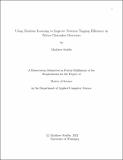| dc.contributor.author | Stubbs, Matthew | |
| dc.date.accessioned | 2022-01-26T23:15:08Z | |
| dc.date.available | 2022-01-26T23:15:08Z | |
| dc.date.issued | 2021-11-25 | |
| dc.identifier.citation | Stubbs, Matthew. Using Machine Learning to Improve Neutron Tagging Efficiency in Water Cherenkov Detectors; A Dissertation Submitted in Partial Fulfillment of the Requirements for the Degree of Master of Science in the Department of Applied Computer Science, University of Winnipeg. Winnipeg, Manitoba, Canada: University of Winnipeg, 2021. DOI: 10.36939/ir.202201261707. | en_US |
| dc.identifier.uri | https://hdl.handle.net/10680/1985 | |
| dc.description.abstract | When an anti-neutrino collides with a proton in the atomic nucleus, it yields an anti-lepton and a free neutron. In a water Cherenkov neutrino detector like Super-K or the next generation Hyper-K, the free neutron is captured by a hydrogen or gadolinium nucleus about one hundred microseconds after the collision. The low-energy signal from the neutron capture (ranging from 2-8 MeV of gamma rays) is recorded by only tens of photomultiplier tubes (PMTs), making neutron captures difficult to distinguish from radioactive decay, muon spallation and other background sources. Improved methodologies for neutron tagging can advance understanding and enable new research over a survey of topics in particle physics. In this research, machine learning techniques are employed to optimize the neutron capture detection capability in the new intermediate water Cherenkov detector (IWCD) for Hyper-K. In particular, boosting decision tree (XGBoost) and graph neural network (GCN, DGCNN) models are developed and benchmarked against a statistical likelihood-based approach, achieving up to a 10% increase in classification accuracy. Characteristic features are also engineered from the datasets and analyzed using SHAP (SHapley Additive exPlanations) to provide insight into the pivotal factors influencing event type outcomes. Three main datasets were used for evaluative purposes in this research, each consisting of roughly 1.6 million events in total, divided nearly evenly between neutron capture and a distinct background electron source. | en_US |
| dc.description.sponsorship | NSERC, WatchMal | en_US |
| dc.language.iso | en | en_US |
| dc.publisher | University of Winnipeg | en_US |
| dc.rights | info:eu-repo/semantics/openAccess | en_US |
| dc.subject | Machine Learning | en_US |
| dc.subject | Neutron Tagging | en_US |
| dc.subject | Graph Neural Networks (GNN) | en_US |
| dc.subject | XGBoost | en_US |
| dc.subject | Particle Physics | en_US |
| dc.title | Using Machine Learning to Improve Neutron Tagging Efficiency in Water Cherenkov Detectors | en_US |
| dc.type | Thesis | en_US |
| dc.description.degree | Master of Science in Applied Computer Science | en_US |
| dc.publisher.grantor | University of Winnipeg | en_US |
| dc.identifier.doi | 10.36939/ir.202201261707 | en_US |
| thesis.degree.discipline | Applied Computer Science | |
| thesis.degree.level | masters | |
| thesis.degree.name | Master of Science in Applied Computer Science | |
| thesis.degree.grantor | University of Winnipeg | |

